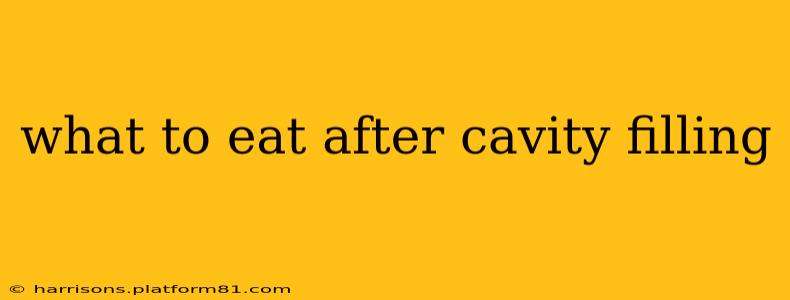What to Eat After a Cavity Filling: A Guide to Post-Procedure Nutrition
Getting a cavity filled is a common dental procedure, but knowing what to eat afterward is crucial for a smooth recovery and preventing complications. The immediate hours and days following the filling are critical for allowing the anesthetic to wear off and the filling to set properly. This guide will walk you through the best foods to eat (and avoid) after your cavity filling, answering common questions many patients have.
What should I eat immediately after a cavity filling?
Immediately following a filling, your mouth might be numb. Stick to soft, cool foods that require minimal chewing. Think yogurt, applesauce, mashed potatoes, or well-cooked oatmeal. Avoid anything hot as this can cause discomfort. The goal here is to avoid putting pressure or strain on the newly filled tooth. Allow your mouth to regain feeling before consuming anything harder.
Can I eat hard foods after a cavity filling?
The answer is a cautious "yes," but it depends on how long it's been and the type of filling. After the numbness subsides, you can gradually reintroduce harder foods, but avoid extremely hard or crunchy items for at least 24 hours. This is because the filling needs time to fully harden and bond with the tooth. Biting down too forcefully can dislodge or damage the filling.
What foods should I avoid after a cavity filling?
There are certain foods and drinks you should avoid, particularly in the first 24-48 hours after a filling. These include:
- Sticky foods: Candy, caramel, taffy, and gum can pull on the filling, increasing the risk of dislodgement.
- Hard foods: Nuts, hard candies, popcorn, and ice can cause cracks or damage to the filling or the surrounding tooth.
- Extremely hot or cold foods: These can cause sensitivity in the treated tooth, which is common in the first few days after a filling.
- Foods that stain easily: Highly pigmented foods and drinks, such as coffee, tea, red wine, and berries, may stain the filling, especially composite fillings.
How long should I avoid certain foods after a cavity filling?
While the immediate 24-48 hours are crucial, it's wise to continue to be mindful of your diet for several days. Avoid excessively hard or sticky foods for at least a week. This allows for proper bonding and reduces the risk of any complications.
What if my filling feels loose or painful after eating?
If you experience any pain, sensitivity, or feel that your filling is loose after eating, contact your dentist immediately. Don't attempt to fix it yourself. Prompt attention can prevent more serious issues.
What are the best foods to eat after a cavity filling to promote healing?
Focus on nutrient-rich foods that are gentle on your teeth and promote healing. This includes:
- Protein-rich foods: Eggs, fish, chicken, and beans help in tissue repair.
- Calcium-rich foods: Dairy products (yogurt, cheese, milk) help strengthen teeth.
- Fruits and vegetables (soft varieties): Provide essential vitamins and minerals, but choose softer options like cooked carrots or well-ripened bananas.
Remember, post-filling dietary choices play a crucial role in the longevity and success of your cavity filling. Following these guidelines will help ensure a comfortable and quick recovery. Always consult your dentist for personalized advice tailored to your specific situation and the type of filling you received.
